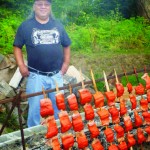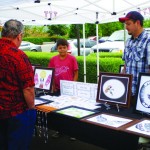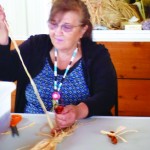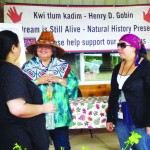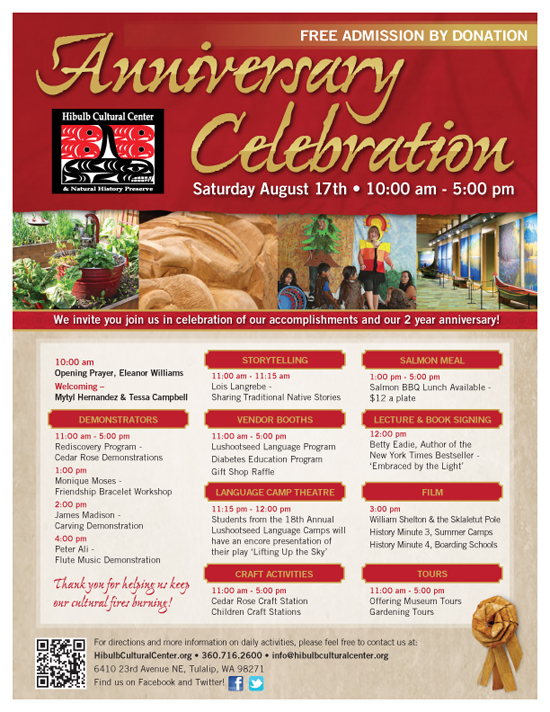Category: Tulalip News
Swәdx’ali, Huckleberry Hill
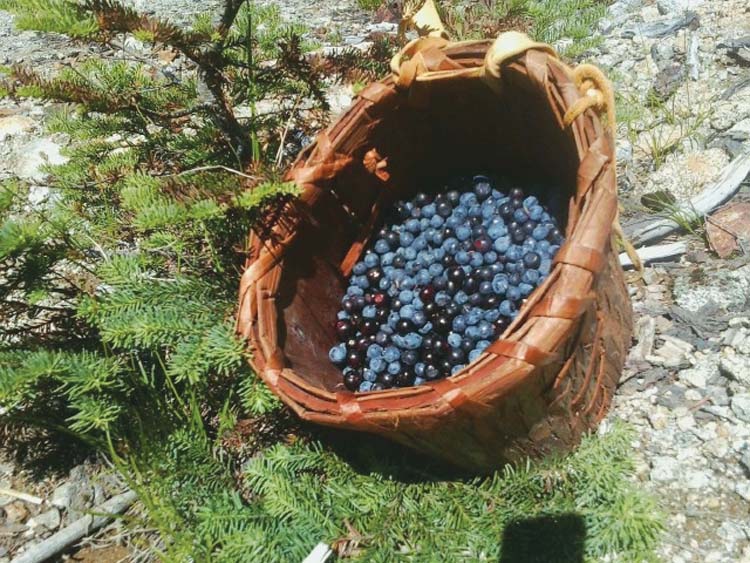
Photo/Ross Fenton
Co-stewardship areas yield bountiful harvests
By Andrew Gobin, Tulalip News, with photo contributions from Ross Fenton
Tulalip − The Tulalip Forestry Department took their summer youth workers huckleberry picking in Swәdx’ali on Harlan Ridge for the Hibulb Cultural Center on Wednesday, the 21st.
The berry patch is one of many co-stewardship areas throughout the Mt. Baker-Snoqualmie National Forest where tribes are collaborating with the Washington Forest Service to preserve and maintain natural flora. Along with gathering berries for the museum, the Tribes’ Forestry Department wants to make the tribal membership aware of Swәdx’ali, and sites like it, where our people can go and harvest traditional plants and foods.
Staining their hands purple and red, the day was also intended as a fun and meaningful way to bring the youths’ time with the department to an end.
“Every year, we look for ways to take the youth out of the office, away from the reservation, and show them what we do, while having a little fun,” said Jason Gobin, Tulalip Forestry Manager. “And the museum will get a nice surprise because they don’t know they’re getting berries today,” he added.
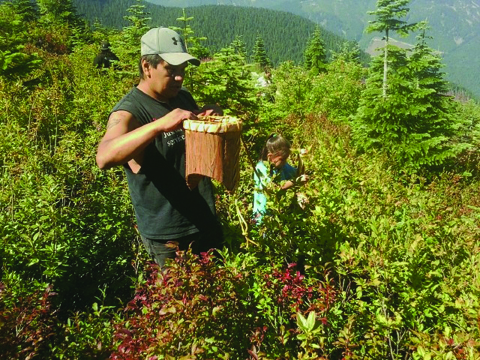
Photo/Andrew Gobin
Swәdx’ali, meaning the place of the mountain huckleberry, is on Harlan Ridge and is covered with berry bushes; the common huckleberry bush with the small red berries, the mountain blueberry bush, and the big leaf huckleberry bush that has the larger black berries. Swәdx’ali is so named because of cultural and biological significance of the area, as the big leaf huckleberry naturally grows in the mountains, above 3,000 feet.
This area is one example of how the Tulalip Tribes is working to reclaim traditional areas. The co-stewardship with the state stems directly from the Point Elliot Treaty, which secured claims to usual and accustomed places, and the privilege of “gathering roots and berries in all open and unclaimed land.”
Reiterating the need to bring awareness to the people, Gobin explained, “These places of co-stewardship are open to all of Tulalip, but there aren’t many who know how to access them, or that we even have these resources available to us.”
For those who would like to access these sites, contact Tulalip Natural Resources at 360-716-4640 or Tulalip Forestry at 360-716-4371.

Photo/Andrew Gobin
Community Meeting, Suicide Prevention, Sept 13
September 10, 2013 is National Suicide Awareness Day. The Washington State Governor’s Proclamation of Suicide Prevention Week is September 8th -14th. Because of the importance of this topic and its effect on our community, Tulalip’s Behavioral Health Mental Wellness Program invites you to join us in turning strategy into action concerning suicide prevention. This can be accomplished through everyone who will play a role in the Suicide Prevention Community Meeting. You are needed and important to this community for the benefit of all of us. Please come and attend.
September 13, 2013, Administration Bldg., Room 162; Dinner 5PM, Meeting 5:30PM
Possible manhunt in progress on Tulalip
By Monica Brown, Tulalip News writer
TULALIP, Wa- A manhunt currently in progress on Marine Drive, Between 7th Ave NE and Maplewood Rd. (14th Ave NE).
A stolen vehicle was recovered and the suspects took off on foot into the woods behind Marine Dr and were believed to be headed towards Maplewood Rd. Tulalip Tribal Police and Snohomish County Sheriff’s are on the scene.
No description of the suspects were given, and they were not specified as dangerous.
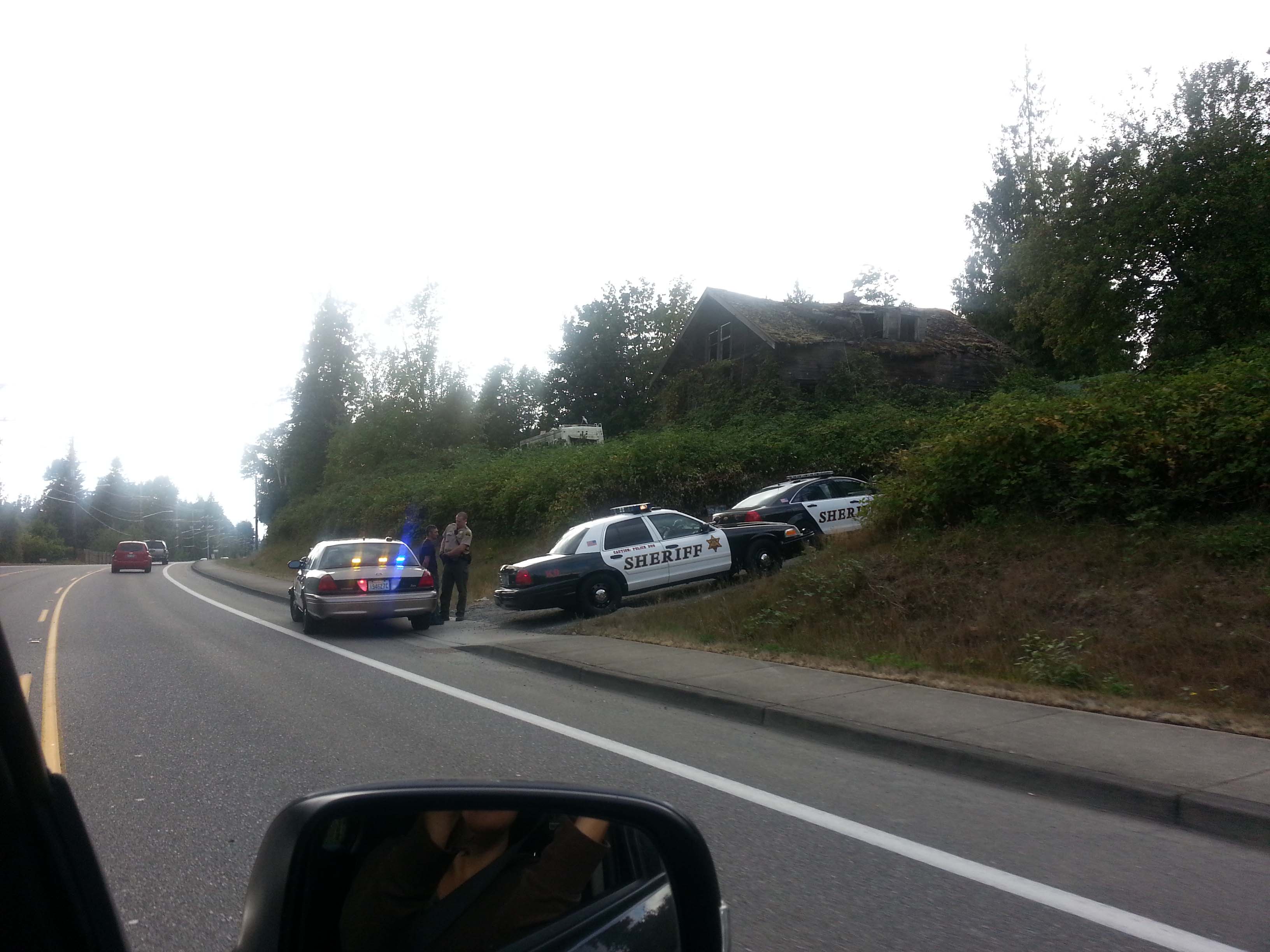
- Heading west on Marine Dr between 7th Ave and Maplewood Rd.
- Photo by Monica Brown
Schimmel Showtime at Tulalip
Shoni and Jude made a stop in Tulalip for some ball time with their fans.
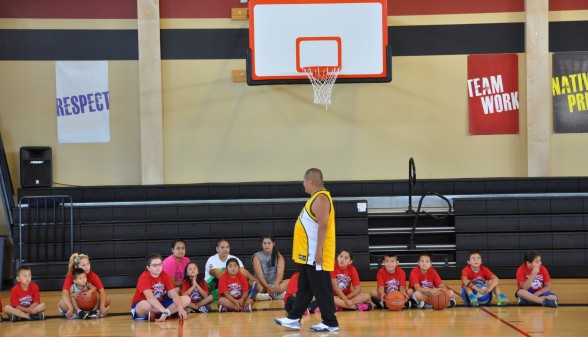
Photo by Monica Brown
By Monica Brown, Tulalip News writer
TULALIP, Wa- Sisters, Shoni and Jude Shimmel, who are known for bringing “rez ball” to college basketball courts, are touring Indian country this summer before they head back to the University of Louisville for fall quarter. During their tour the duo planned a visit to Tulalip Reservation’s, Don Hatch Gym. Shoni and Jude came to meet their fans and motivate the Tulalip kids into dedicating more passion when playing basketball, or any sport in general.
Kids and fans alike packed the gym on Saturday August 17th to meet the famous Shimmel sisters and practice with them. Fans donned their Native pride shirts, with backs that read, “Shimmel Showtime”. A reference that recalls the memory of the “Shimmel Show”, a nationally televised game from this past year in which Louisville Cardinals beat the Tennessee Lady Vols 86 to 78, and the Schimmel sisters scored a combined 39 points throughout the game which was dubbed “Shimmel Show” by ESPN.

The Shimmel sisters have been named the “Umatilla Thrilla” because they come from the Umatilla Reservation in Pendleton, Oregon and demonstrate the “rez ball” technique in their play. Rez ball, not something you would normally see in use on professional courts, is a playing style where the players are more aggressive, they move at a fast, consistent tempo to complete quick scoring and maintain an assertive defense.
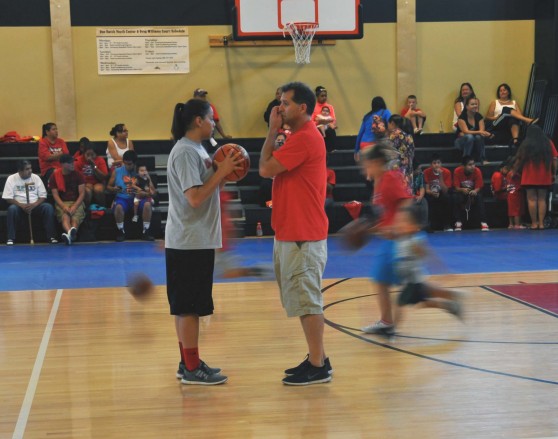
Photo by Monica Brown


Photo by Monica Brown
August 21, 2013 syəcəb
Hibulb celebrates its second year

Donations to benefit the Natural History Preserve
By Andrew Gobin, Tulalip News
Tulalip − For the second year the Hibulb Cultural Center in Tulalip held an open house for the anniversary celebration Saturday, August 17th. After a 20 year dream, and more than ten years of planning, the long awaited museum opened in 2011. This year, the emphasis of the anniversary was funding the Hibulb natural history preserve.
“We are not a profit driven operation. In fact we make very little money. Most of the museum operations are funded from donations or through grants, instead of tribal hard dollars,” explained Mytyl Hernandez, Hibulb’s marketing and membership manager.
Attendees could wander through the vendors or sit in on any number of cultural seminars held throughout the day. The museum had items for sale in the seminars as well, and held a raffle for Hibulb merchandise.
The day’s events began by remembering the late Henry “Hank” Gobin, former museum director, who passed away earlier this year. The completion of Tulalip’s own natural history preserve was his dream since he began his work in revitalizing the culture at Tulalip.
For more information on the Hibulb Cultural Center visit www.hibulbculturalcenter.org.
Hatching nest eggs, a walk in Finance Park
Native youth attend Junior Achievement camp
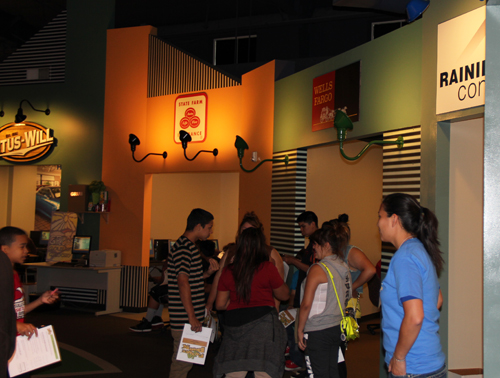
By Andrew Gobin, Tulalip News
Students from the Tulalip Tribes Summer Youth Program spent the day in Finance Park at Junior Achievement World in Auburn, on Thursday, August 15th. The day at the park is the culmination of a two-week educational JA (Junior Achievement) camp at Tulalip. The camp is unique to the tribes as it targets what Tulalip students are calling their “18 money,” the trust fund per capita that the tribe sets aside for them until they graduate. The Tulalip camp focuses on the trust fund, and teaches how to make that money go further.
“Junior Achievement is actually a k-12 curriculum,” explains Gary Hauff, regional director for Junior Achievement. “Typically we go into schools and offer education programs for class credit. For the tribes, we are trying something different. The summer camp is unique to Tulalip, geared towards teaching personal finance responsibility and budgeting agendas.”
“At JA we work with the youth to plant the seeds of financial responsibility and stability,” added Sue Elkin, manager at JA World.
Finance Park is designed as a virtual city where students can practice being adults, and put into action what they learned at camp. Arriving at JA World, the students are given an identity complete with a salary, a family, pets, and a debit card. Students then buy or rent a house or apartment, purchase a car that adequately fit the demands of their virtual life, collect and pay their bills, and even make time for vacations. Along with projected costs, kids learn to deal with unexpected costs that arise in everyday life. Students tour the park, collecting bills and shopping, and making the dreaded stop at the chance station, where they draw cards that may result in an unlucky additional cost to their budget, such as taking their pet to the vet.
“We get a real look at life, and what the costs are,” said Bradley Fryberg. “Here [Finance Park] I make $48,000 a year, I have no kids, I’m single, 30, and have an apartment and a sports car.”
Some students juggled two or three kids and drove mini vans.
“Junior Achievement teaches us to be responsible with our money,” said Bryce Juneau Jr. who is planning on saving his trust money until after college.
Students learn about stocks and bonds, compound interest accounts, the risks associated with both of those, and the possible gains they offer.
“Just as life is multi-faceted, we at JA are diversifying,” explained Elkin. “We used to be strictly business oriented, then last year we started branching out into the sciences and other fields. This year we worked to incorporate art and music into the program.”
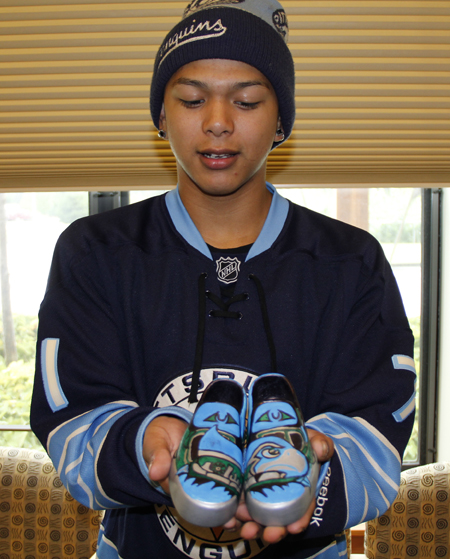
This included a little fun competition working with shoe designs and a special appearance by Native shoe designer Louie Gong.
Gong spoke to the students about his designs and the work it entails. He provided shoe forms called “mockups” for the kids to express their creative talent on. The shoes were then voted on and the student with the winning shoe design received tickets to a Mariners game.
Tulalip’s Israel Simpson designed the winning pair of shoes. “I just picked up the pens and kept going. Inspired from my auntie, always saying, draw what you feel.”
The camp encourages education, both in the completion of high school and in pursuing higher education. This is important, because many do not realize that should they not complete high school or get their G.E.D., they with not get their trust per capita until they are 21.
Many different post high school options are explained including trade schools, community colleges, universities, online degrees, and entrepreneurship.
Hatchery Facelift Boosts Salmon Runs
Facility upgrades raise the survival rate

By Andrew Gobin, Tulalip News
Tulalip−Though marauding sea lions have been a constant nuisance to hatchery operations, it is now apparent they stand to threaten the success of hatchery runs as they have become more aggressive, pushing further upstream into holding areas for returning salmon. Through a series of upgrades to the facilities at the Bernie ‘Kai Kai’ Gobin Hatchery at Tulalip, changes are being made to optimize salmon returns.
Newly built sea lion fences at Battle Creek and below the hatchery dam and fish ladder prevent sea lions from going up stream, while allowing salmon to pass through.
“At low tide, the sea lions are belly-crawling up Battle Creek and taking females out of the holding area,” said Jesse Rude, hatchery assistant manager. “We can’t have a shortage of eggs, otherwise we have no fish to hatch.” Rude further noted that, “these fences are first of their kind. No other system like it is known to be used, or in existence.”
At the damn, a small pond with a barricade of rocks sits below the fish ladder, behind the new fence. This allows the salmon to get behind the fence where they are protected, while keeping the salmon from going upstream too early; another new technique the hatchery is trying. “Incidentally, this is good for the fishermen too, keeps the fish out in the bay to be caught,” noted Rude.
At the top of the ladder, a mechanized holding pen and fish lift are installed. The lift looks similar to a car elevator from a parking garage, and can lift comparable weight loads. This allows the salmon to be pulled out and processed more quickly than pitching fish by hand.
The last major upgrades were the installation of birdnetting, to keep birds from getting an easy meal in the lower ponds and creeks, and the new larger pond at the hatchery.
“With the larger pond, we are able to do a lot more Chinook,” said Rude, referring to larger quantities of eggs, and later smolt, that the pond can hold relative to the area needed to have a productive salmon hatch.
“Last year we hatched 1.5 million Coho, and we released a record 1.3 million fish.” Typically, the rate of survival is 50% to 60%; meaning only half of what is hatched actually gets released.
Ironically, the upgrades from 2005 and 2006 led to the record-breaking release of Coho. The snow built up on the birdnetting, breaking the nets and dragging the support posts, and the Jersey barriers that anchored them, into the fish ponds.
“We had to move all of the fish up to the new larger pond,” Rude explained. As a result, the Coho run was over-wintered, meaning they were more mature than normal when released.
They were free of predation back up in the pond as well. Rude said, “the otters are like rats in the ponds. They are everywhere and they eat the fish. The last couple of years we’ve had to hire predator control to manage the otters.”
When asked about the success of over-wintering and potential continuation, Rude said they would be trying similar methods with all of their runs this year.
Other upgrades include expanded feed and storage facilities, covered or shaded ponds, a concrete fish weir put in at Battle Creek, and expanding and repairing the birdnetting for all hatchery creeks and ponds.
Celebrating Two Years of Accomplishments
Tulalip Hibulb Cultural Center is celebrating two years of sharing Coast Salish culture and highlighting the stories, people, art and history of Tulalip.
Saturday, August 17, 10 am to 5pm. Included in the activities are carving, beading and flute music demonstrations, storytelling, craft activities, a salmon lunch and a special performance by the Tulalip Lushootseed Language Camp students.
For directions and more information visit HibulbCulturalCenter.org or call 360.716.2600
6410 23rd Avenue NE, Tulalip WA 98271









